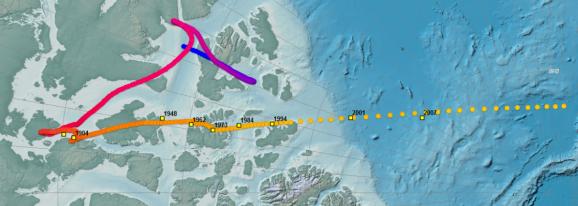 Recently, the media has somewhat breathlessly reported that the usually slow drift of the magnetic north pole has sped up dramatically. My favorite headline is from NPR which reads, “As Magnetic North Pole Zooms Toward Siberia, Scientists Update World Magnetic Model.” Is the magnetic pole really zooming?
Recently, the media has somewhat breathlessly reported that the usually slow drift of the magnetic north pole has sped up dramatically. My favorite headline is from NPR which reads, “As Magnetic North Pole Zooms Toward Siberia, Scientists Update World Magnetic Model.” Is the magnetic pole really zooming?
Where magnetic north had been moving at an average speed of around 9 miles per year for some time, it has recently sped up to 34 miles per year. The increase was significant enough require a revision to the World Magnetic Model, (WMM) maintained jointly by the UK and the US. The model is typically updated every five years but was given a quick tweak recently to account for increased motion.
While the increased motion is notable, to say that it is zooming is more than a bit hyperbolic. Even at 34 miles per year, the rate of drift is still ten times slower than the speed of an average garden snail. So call it a very slow zoom.
The drifting of the magnetic north pole is thought to be due to the motion of a spinning mass of molten iron and nickel 1,800 miles below the surface. As the molten core moves through the mantle it changes the magnetic field. Why is the pole moving faster now? No one really knows.
So, is this a big deal. Obviously, for scientists who study magnetism and plate tectonics, the answer is an emphatic yes. For the rest of us, maybe not so much.
How much exactly will the revision someone using a magnetic compass? It depends where you are. The further north you go the more the movement of the magnetic pole matters. Here on the west bank of the Hudson River by New York City, the difference in declination, the angular difference between magnetic and true north, between 2015 and 2019 is exactly one-tenth of one degree, which is meaningless for anyone trying to steer a compass course.
Oddly enough, users of some GPS units and smartphones may be more impacted by the change than users of conventional magnetic compasses. Many GPS units are equipped with electronic compasses and WMM to back up the GPS calculations when satellite signals are weak or blocked. Likewise, WMM comes pre-installed in Android and iOS devices.
Thanks to Phil Leon for contributing to this post.

Read the longer version:
Earth’s magnetic
field is acting up
and geologists
don’t know why
https://www.nature.com/articles/d41586-019-00007-1/
Hello Putin, Canada here, can we have our pole back.
The difference between magnetic north and true north is called variation, not declination. I was an aeronautical navigator in USAF ( 1955-1964).
No. The difference between magnetic north and true north is called variation or declination. Not sure what the USAF taught you, but declination is the more widely used term of the two. (Bowditch also called it grivation.)
https://en.wikipedia.org/wiki/Magnetic_declination
Always Variation on UK charts 🙂
Always VARIATION on US Charts as well. Declination refers to the movement of planets, the moon, and stars in relation to the earth’s horizon…. but that is just from memory, you can look it up.
You are right. Oddly enough, the NOAA charts use “variation” based on the World Magnetic Model (WMM) while the NOAA National Center for Environmental Information (NCIE) and the folks who generate the WMM from which the charts are updated prefer “declination.” The NOAA
phone compass app also uses declination. Either works.
https://www.ngdc.noaa.gov/geomag/declination.shtml
Perhaps the use of ‘variation’ on charts is a reminder to navigators that the number quoted is a variable, dynamic in both time and location. It is usually followed by a rate of change per annum in parentheses.